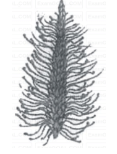31 Years NEET Previous Year Questions: Sexual Reproduction in Flowering Plants - 1 - NEET MCQ
29 Questions MCQ Test - 31 Years NEET Previous Year Questions: Sexual Reproduction in Flowering Plants - 1
Identify the set of correct statements:
A. The flowers of Vallisneria are colourful and produce nectar.
B. The flowers of water lily are not pollinated by water.
C. In most of water-pollinated species, the pollen grains are protected from wetting.
D. Pollen grains of some hydrophytes are long and ribbon like.
E. In some hydrophytes, the pollen grains are carried passively inside water.
Choose the correct answer from the options given below. (2024)
A. The flowers of Vallisneria are colourful and produce nectar.
B. The flowers of water lily are not pollinated by water.
C. In most of water-pollinated species, the pollen grains are protected from wetting.
D. Pollen grains of some hydrophytes are long and ribbon like.
E. In some hydrophytes, the pollen grains are carried passively inside water.
Choose the correct answer from the options given below. (2024)
Identify the correct description about the given figure: (2024)


Large, colourful, fragrant flowers with nectar are seen in (NEET 2023)
What is the function of tassels in the corn cob? (NEET 2023)
In angiosperm, the haploid, diploid and triploid structures of a fertilized embryo sac sequentially are: (NEET 2023)
Identify the incorrect statement related to Pollination: (NEET 2022)
Given below are two statements:
Statement I: Cleistogamous flowers are invariably autogamous.
Statement II: Cleistogamy is disadvantageous as there is no chance for cross pollination.
In the light of the above statements, choose the correct answer from the options given below: (NEET 2022)
The residual persistent part which forms the perisperm in the seeds of beet is [NEET 2022 Phase 2]
To ensure that only the desired pollens fall on the stigma in artificial hybridization process
(a) the female flower buds of plant producing unisexual flowers need not be bagged.
(b) there is no need to emasculate unisexual flowers of selected female parent
(c) emasculated flowers are to be bagged immediately after cross pollination
(d) emasculated flowers are to be bagged after removal of anthers
(e) bisexual flowers, showing protogyny are never selected for cross
Choose the correct answer from the options given belows. [NEET 2022 Phase 2]
In general the egg apparatus of embryo sac in angiosperm consists of [NEET 2022 Phase 2]
The term used for transfer of pollen grains from anthers of one plant to stigma of a different plant which during pollination, brings genetically different types of pollen grains to stigma, is: (2021)
A typical angiosperm embryo sac at maturity is: (2021)
In some members of which of the following pairs of families, pollen grains retain their viability for months after release? (2021)
In water hyacinth and water lily, pollination takes place by:
(2020)
The plant parts which consists of two generation one within the other: (2020)
(a) Pollen grains inside the anther
(b) Germinated pollen grain with two male gametes
(c) Seed inside the fruit
(d) Embryo sac inside the ovule
In some plants, the thalamus contributes to fruit formation. Such fruits are termed as: (2020)
What type of pollination takes place in Vallisneria? (2019)
Persistent nucellus in the seed is known as: (2019)
Which one of the following, both autogamy and geitonogamy are prevented?
(2019)
Which of the following has proved helpful in preserving pollen as fossils?
(2018)
Double fertilisation is (2018)
Which of the following statements is not correct? [2016]
Which one of the following statements is not true? [2016]
Filiform apparatus is characteristic feature of: [2015 RS]
Which of the following are the important floral rewards to the animal pollinators? [2015 RS]
The hilum is a scar on the: [2015 RS]
Which one of the following statements is not true? [2015 RS]
Which one of the following may require pollinators, but is genetically similar to autogamy? [2015 RS]
Function of filiform apparatus is to: [2014]






















